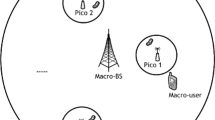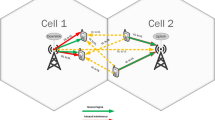Abstract
In this paper, we propose an adaptive beam deactivation scheme to mitigate inter-cell interference for a coordinated single-cell beamforming downlink transmission with limited feedback in a multi-cell multiple-input multiple-output wireless network. In the proposed scheme, each user feeds the indices of a desired beam and other undesired beams, and a certain channel quality indicator back to its home base station (BS). Based on the returned information, coordinating BSs assign each user to a serving BS by exploiting the proposed transmitting user set selection algorithm. Both exact and asymptotic sum rate analyses are done on the resulting system. Selected numerical examples are provided to show that the proposed scheme achieves noticeable sum rate gain compared to the conventional zero-forcing based coordinated multi-cell system with reduced feedback load.





Similar content being viewed by others
References
Goldsmith, A., Jafar, S., Jindal, N., & Vishwanath, S. (2003). Capacity limits of mimo channels. IEEE Journal on Selected Areas in Communications, 21(5), 684–702.
Andrews, J., Choi, W., & Heath, R. (2007). Overcoming interference in spatial multiplexing mimo cellular networks. IEEE Wireless Communications, 14(6), 95–104.
Karakayali, M., Foschini, G., & Valenzuela, R. (2006). Network coordination for spectrally efficient communications in cellular systems. IEEE Wireless Communications, 13(4), 56–61.
Shamai, S., Somekh, O., & Zaidel, B.M. (2004). Multi-cell communications: An information theoretic perspective, In: Proceedings of the Joint Workshop on Communications and Coding (JWCC04), pp. 14–17.
Venkatesan, S., Huang, H., Lozano, A., & Valenzuela, R. (2009). A wimax-based implementation of network mimo for indoor wireless systems. EURASIP Journal on Advances in Signal Processing, 2009(9), 9.
Foschini, G., Karakayali, K., & Valenzuela, R. (2006). Coordinating multiple antenna cellular networks to achieve enormous spectral efficiency. IEE Proceedings Communications, 153(4), 548–555.
Qiang, L., Yang, Y., Shu, F., & Gang, W. (2010). Coordinated beamforming in downlink comp transmission system. In 2010 5th International ICST Conference on Communications and Networking in China (CHINACOM), pp. 1–5.
Zhang, J., & Andrews, J. (2010). Adaptive spatial intercell interference cancellation in multicell wireless networks. IEEE Journal on Selected Areas in Communications, 28(9), 1455–1468.
Dahrouj, H., & Yu, W. (2008). Coordinated beamforming for the multi-cell multi-antenna wireless system. In 42nd Annual Conference on Information Sciences and Systems, 2008, CISS 2008d, pp. 429–434.
Zhang, H., Mehta, N., Molisch, A., Zhang, J., & Dai, H. (2008). Asynchronous interference mitigation in cooperative base station systems. IEEE Transactions on Wireless Communications, 7(1), 155–165.
Yoo, T., & Goldsmith, A. (2006). On the optimality of multiantenna broadcast scheduling using zero-forcing beamforming. IEEE Journal on Selected Areas in Communications, 24(3), 528–541.
David, H. A., & Nagaraja, H. N. (1970). Order statistics. Wiley Online Library, doi:10.1002/0471667196.ess6023.pub2.
Gradshteyn, I. S., & Ryzhik, I. M. (1994). Table of integrals, series, and products. corrected and enlarged ed. San Diego, CA, USA: Academic Press.
Santipach, W., & Honig, M. (2003). Asymptotic performance of mimo wireless channels with limited feedback. In Proceedings IEEE Military Communications Conference 2003. MILCOM ’03, 1, pp. 141–146.
Ko, Y.-C., Yang, H.-C., Eom, S.-S., & Alouini, M.-S. (2007). Adaptive modulation with diversity combining based on output-threshold mrc. IEEE Transactions on Wireless Communications, 6(10), 3728–3737.
Yang, H.-C., & Alouini, M.-S. (2011). Order statistics in wireless communications: Diversity, adaptation, and scheduling in MIMO and OFDM systems. New York, NY, USA: Cambridge University Press. ISBN-10 0521712459.
Acknowledgments
This paper was supported by Wonkwang University in 2014.
Author information
Authors and Affiliations
Corresponding author
Appendices
Appendix 1
It is possible to obtain the joint pdf \(f_{{\mathbf{Y}}_{(i)},{\mathbf{V}}_{i+1}^{M(N-1)}}(y_{i},v_2)\) by integrating the joint pdf \(f_{{\mathbf{V}}_{1}^{i-1},{\mathbf{Y}}_{(i)},{\mathbf{V}}_{i+1}^{M(N-1)}}(v_1,y_{i},v_2)\) [15, Eq. 28] with regard to \(v_1\) as follows:
From (51), the joint pdf \(f_{{\mathbf{Y}}_{(N_d)},{\mathbf{Z}}}(y_{N_d},z)\), where \({\mathbf{Z}}=\frac{N-1}{N_a}{\mathbf{V}}_{N_d+1}^{M(N-1)}\) and \(N_a=M(N-1)-N_d\), can be obtained after some modifications as
where \(U(\cdot )\) is an unit step function. Now, we can obtain the pdf of Z, \(f_{\mathbf{Z}}(z)\), from (52) by integrating out \(y_{N_d}\), yielding
Appendix 2
Regarding the joint pdf \(f_{{\mathbf{Y}}_{(i)},{\mathbf{Z}}}(y_{N_d},z)\) given in (52), we derive the joint pdf \(f_{{\mathbf{Y}}_{(i)},{\mathbf{Z}}}(y_{i},z)\) for the cases of \(1\le i<N_d, i=N_d+1, N_d+1<i<M(N-1)\) and \(i=M(N-1)\) as follows:
-
1.
Case 1: \(1\le i<N_d\)
Based on Bayes’ rule, we can obtain the joint pdf \(f_{{\mathbf{Y}}_{(i)},{\mathbf{Y}}_{(N_d)},{\mathbf{Z}}}(y_{i},y_{N_d},z)\) from (22) and (52) as
$$\begin{aligned} f_{{\mathbf{Y}}_{(i)},{\mathbf{Y}}_{(N_d)},{\mathbf{Z}}}(y_{i},y_{N_d},z)=f_{{\mathbf{Y}}_{(i)}|{\mathbf{Y}}_{(N_d)}=y_{N_d}}(y_i)f_{{\mathbf{Y}}_{(N_d)},{\mathbf{Z}}}(y_{N_d},z). \end{aligned}$$(54)Then we can easily obtain the joint pdf \(f_{{\mathbf{Y}}_{(i)},{\mathbf{Z}}}(y_{i},z)\) by integrating out \(y_{N_d}\) as
$$\begin{aligned} f_{{\mathbf{Y}}_{(i)},{\mathbf{Z}}}(y_{i},z)=\int _{\frac{z}{N-1}}^{y_i}f_{{\mathbf{Y}}_{(i)}|{\mathbf{Y}}_{(N_d)}=y_{N_d}}(y_i)f_{{\mathbf{Y}}_{(N_d)},{\mathbf{Z}}}(y_{N_d},z){{{\rm d}}}y_{N_d},\,\,y_i>y_{N_d}. \end{aligned}$$(55) -
2.
Case 2: \(i=N_d+1\)
We can obtain the joint pdf \(f_{{\mathbf{Y}}_{(N_d+1)},{\mathbf{Z}}}(y,z)\) by using (51) as
$$\begin{aligned} f_{{\mathbf{Y}}_{(N_d+1)},{\mathbf{Z}}}(y,z)=\frac{N_a}{N-1}f_{{\mathbf{Y}}_{(N_d+1)},{\mathbf{V}}_{N_d+2}^{M(N-1)}}\left( y,\frac{N_az}{N-1}-y\right) , \,\, \frac{z}{N-1}<y<\frac{N_az}{N-1}. \end{aligned}$$(56) -
3.
Case 3: \(N_d+1<i<M(N-1)\)
To derive the joint pdf \(f_{{\mathbf{Y}}_{(i)},{\mathbf{Z}}}(y_{i},z)\), we first derive the joint pdf of \({\mathbf{Y}}_{(N_d)}, {\mathbf{V}}_{N_d+1}^{i-1}\) \({\mathbf{Y}}_{(i)}\), and \({\mathbf{V}}_{i+1}^{M(N-1)}\) by applying Bayes’ rule as
$$\begin{aligned}&f_{{\mathbf{Y}}_{(N_d)},{\mathbf{V}}_{N_d+1}^{i-1},{\mathbf{Y}}_{(i)},{\mathbf{V}}_{i+1}^{M(N-1)}}(y_{N_d},v_1,y_{i},v_2) \\&\quad=f_{{\mathbf{V}}_{N_d+1}^{i-1}|{\mathbf{Y}}_{(N_d)}=y_{N_d},{\mathbf{Y}}_{(i)}=y_i}(v_1)f_{{\mathbf{Y}}_{(N_d)}|{\mathbf{Y}}_{(i)}=y_i}(y_{N_d}) \\&\qquad \times f_{{\mathbf{Y}}_{(i)},{\mathbf{V}}_{i+1}^{M(N-1)}}(y_i,v_2). \end{aligned}$$(57)The second and third terms in the right side of the expression (57) can be obtained from (22) and (51), respectively, after some modifications. The conditional pdf \(f_{{\mathbf{V}}_{N_d+1}^{i-1}|{\mathbf{Y}}_{(N_d)}=y_{N_d},{\mathbf{Y}}_{(i)}=y_i}(v_1)\) can be obtained from [16, Eq. 3.55] as
$$\begin{aligned}&f_{{\mathbf{V}}_{N_d+1}^{i-1}|{\mathbf{Y}}_{(N_d)}=y_{N_d},{\mathbf{Y}}_{(i)}=y_i}(v_1) \\&\quad=\sum ^{i-N_d-1}_{j=0}\left( \begin{array}{c} i-N_d-1 \\ j \\ \end{array}\right) \frac{(-1)^j[v_1-(i-j-N_d-1)y_i-jy_{N_d}]^{i-N_d-2}}{(i-N_d-2)!(e^{-y_i}-e^{-y_{N_d}})^{i-N_d-1}} \\&\qquad \times e^{-v_1}\cdot U(v_1-(i-j-N_d-1)y_i-jy_{N_d}),(i-N_d-1)y_i<v_1<(i-N_d-1)y_{N_d}. \end{aligned}$$(58)Therefore, we can write the joint pdf \(f_{{\mathbf{Y}}_{(N_d)},{\mathbf{V}}_{N_d+1}^{i-1},{\mathbf{Y}}_{(i)},{\mathbf{V}}_{i+1}^{M(N-1)}}(\cdot ,\cdot ,\cdot ,\cdot )\) as
$$\begin{aligned}&f_{{\mathbf{Y}}_{(N_d)},{\mathbf{V}}_{N_d+1}^{i-1},{\mathbf{Y}}_{(i)},{\mathbf{V}}_{i+1}^{M(N-1)}}(y_{N_d},v_1,y_{l},v_2)& \\&\quad=\frac{[M(N-1)]!e^{-(N_dy_{N_d}+v_1+y_i+v_2)}}{(M(N-1)-i)!(M(N-1)-i-1)!(N_d-1)!(i-N_d-1)!(i-N_d-2)!} \\&\qquad \times \sum ^{i-N_d-1}_{j=0}\sum _{k=0}^{M(N-1)-i}\left( \begin{array}{c} i-N_d-1 \\ j \\ \end{array}\right) \left( \begin{array}{c} M(N-1)-i \\ k \\ \end{array} \right) (-1)^{j+k} \\&\qquad \times [v_1-(i-j-N_d-1)y_i-jy_{N_d}]^{i-N_d-2}(v_2-ky_i)^{M(N-1)-i-1} \\&\qquad \times U(v_1-(i-j-N_d-1)y_i-jy_{N_d})U(v_2-ky_i), \\&\qquad \quad (i-N_d-1)y_i<v_1<(i-N_d-1)y_{N_d},v_2<(M(N-1)-i)y_i. \end{aligned}$$(59)After that, we derive the joint pdf \(f_{{\mathbf{V}}_{N_d+1}^{i-1},{\mathbf{Y}}_{(i)},{\mathbf{V}}_{i+1}^{M(N-1)}}(v_1,y_{i},v_2)\) by integrating out \(y_{N_d}\) as
$$\begin{aligned}&f_{{\mathbf{V}}_{N_d+1}^{i-1},{\mathbf{Y}}_{(i)},{\mathbf{V}}_{i+1}^{M(N-1)}}(v_1,y_{i},v_2) \\&\quad=\int _{\frac{v_1}{i-N_d-1}}^{\infty }f_{{\mathbf{Y}}_{(N_d)},{\mathbf{V}}_{N_d+1}^{i-1},{\mathbf{Y}}_{(i)},{\mathbf{V}}_{i+1}^{M(N-1)}}(y_{N_d},v_1,y_{i},v_2){{{\rm d}}}y_{N_d}. \end{aligned}$$(60)Now we can derive the joint pdf \(f_{{\mathbf{Y}}_{(i)},{\mathbf{V}}_{N_d+1}^{M(N-1)}}(y_{i},v_3)\) from (60) as
$$\begin{aligned}&f_{{\mathbf{Y}}_{(i)},{\mathbf{V}}_{N_d+1}^{M(N-1)}}(y_{i},v_3) \\&\quad=\int _{0}^{[M(N-1)-i]y_i}f_{{\mathbf{V}}_{N_d+1}^{i-1},{\mathbf{Y}}_{(i)},{\mathbf{V}}_{i+1}^{M(N-1)}}(v_3\!-\!v_2\!-\!y_i,y_{i},v_2){{{\rm d}}}v_2, \\ \end{aligned}$$(61)where \(v_2<v_3-(l-N_d)y_l\).
Consequently, we can obtain the joint pdf \(f_{{\mathbf{Y}}_{(l)},{\mathbf{Z}}}(y_l,z)\) from (61) as
$$\begin{aligned} f_{{\mathbf{Y}}_{(i)},{\mathbf{Z}}}(y_{i},z)=\frac{N_a}{N-1}f_{{\mathbf{Y}}_{(i)},{\mathbf{V}}_{N_d+1}^{M(N-1)}}\left( y_{i},\frac{N_az}{N-1}\right) , \,\, y<\frac{N_az}{N-1}. \end{aligned}$$(62) -
4.
Case 4: \(i=M(N-1)\)
We can obtain the joint pdf \(f_{{\mathbf{Y}}_{(N_d+1)},{\mathbf{Z}}}(y,z)\) by using (16) and (58) as
$$\begin{aligned}&f_{{\mathbf{Y}}_{(M(N-1))},{\mathbf{Z}}}(y_2,z) \\&\quad=\frac{N_a}{N-1}\int _{\frac{\frac{N_az}{N-1}-y_2}{N_a-1}}^{\infty } f_{{\mathbf{V}}_{N_d+1}^{M(N-1)-1}|{\mathbf{Y}}_{(N_d)}=y_{1},{\mathbf{Y}}_{(M(N-1))}=y_2}\left( \frac{N_az}{N-1}-y_2\right) \\&\qquad \times f_{{\mathbf{Y}}_{(N_d)},{\mathbf{Y}}_{(M(N-1))}}(y_1,y_2){{{\rm d}}}y_1,\,\frac{z}{N-1}>y_2. \end{aligned}$$(63)
Appendix 3
The feedback SINR of the first selected user is always the largest one among the \(NK\) feedback SINRs and \(p_{{\varvec{\Gamma }}^{{{\rm out}}}_1}({{{\mathcal {S}}}_{i}^{{}_{{{\rm out}}}}},NK,1)\) can be obtained easily as in (32). On the other hand, if the number of users in the user set \({{\mathcal {U}}}_2\) (or \({{\mathcal {Q}}}\) for the second user selection in Step 3 and Step 4d of the proposed algorithm) is \(k(=1,\ldots ,K)\), then the feedback SINR of the second user is the second one to \((NK\!-k\!+1)\)-th largest feedback SINRs. The probability that the feedback SINR of the second user is to be \(l\)-th \((=2,\ldots ,NK\!-k\!+1)\) largest one among \(NK\) ones is given as \(\frac{{}_{(NK\!-l)}{{\mathcal {C}}}_{(k-1)}}{{}_{(NK\!-\!1)}{{\mathcal {C}}}_{k}}\).
The probability that the number of users in the user set \({{\mathcal {U}}}_2\) in Step 2 of the proposed algorithm is \(k\) is \({}_{K}{{\mathcal {C}}}_{k}\left( \left( \frac{M-N_d}{M}\right) ^2\right) ^k\left( 1-\left( \frac{M-N_d}{M}\right) ^2\right) ^{K-k}\). In this case, the interference term in the output SINR of the second selected user is \({\mathbf{Y}}_{j}\) \((N_d<j\le M(N-1))\). However, the probability of the number of users in \({{\mathcal {Q}}}\) for the second user selection of Step 4d to be \(k\) can be formulated as follows. Note that each of the K users wants one in the undesired beam set of the first selected user or the desired beam of the first selected user.
-
1.
Among the \(K\) users, only the desired beams of the \(k\) users, each with the desired beam of the first selected user in its undesired beam set, are not included in the undesired beam set of the first selected user. In this case, the probability that the number of the users in \({{\mathcal {Q}}}\) is \(k\) is \({}_{K}{{\mathcal {C}}}_{k}\left( \left( \frac{M-N_d}{M}\right) \frac{N_d}{M}\right) ^k\left( \frac{N_d}{M}\right) ^{K-k}\) and the interference term in the output SINR of the second selected user is \({\mathbf{Y}}_j\) \((1\le j\,\le\,N_d)\).
-
2.
Among the \(K\) users, only the desired beams of \(k\) users, each without the desired beam of the first selected user in its undesired beam set, are included in the undesired beam set of the first selected user. In addition, each of the other \(K-k\) users desires the one of the beam in the undesired beam set of the first selected user and undesires the desired beam of the first selected user. In this case, the probability that the number of the users in \({{\mathcal {Q}}}\) is \(k\) is \({}_{K}{{\mathcal {C}}}_{k}\left( \left( \frac{M-N_d}{M}\right) \frac{N_d}{M}\right) ^k\left( \frac{N_d}{M}\right) ^{2(K-k)}\) and the interference term in the output SINR of the second selected user is \({\mathbf{Y}}_j\) \((N_d<j\,\le\,M(N-1))\).
-
3.
Each of all the K users desires the one of the beam in the undesired beam set of the first selected user and undesires the desired beam of the first selected user. In this case, the probability is \(\left( \frac{N_d}{M}\right) ^{2K}\) and the interference term in the output SINR of the second selected user is \({\mathbf{Y}}_j\) \((1\le j \le N_d)\).
Consequently, we can obtain \(p_{{\varvec{\Gamma }}^{{{\rm out}}}_2}({{{\mathcal {S}}}_{i}^{{}_{{{\rm out}}}}},k,l)\) as in (33).
Rights and permissions
About this article
Cite this article
Oh, J., Lee, JH., Yoon, D. et al. Adaptive Beam Deactivation for Coordinated Multi-cell System with Limited Feedback. Wireless Pers Commun 83, 2151–2175 (2015). https://doi.org/10.1007/s11277-015-2506-z
Published:
Issue Date:
DOI: https://doi.org/10.1007/s11277-015-2506-z




